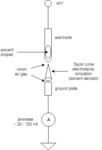brandon.tarr@restek.com
Newbie level 3
Hi all. I am experimenting with electrospray ionization. The setup has a 4kV power supply connected to an electrode that is separated from a return lug (or ground plate) via an air gap, followed by an inline pico-ammeter and finally ground. The way this works is that a small drop of solvent is applied to the electrode, the 4kV power supply is energized, and the solvent forms an aerosol electrospray "Taylor cone" between the electrode and return lug. When this is occurring (it is not especially visible except via laser light) the inline pico-ammeter reads somewhere on the order of 20-100 nA resulting from the ion transfer.
I would like to test a very large number of electrodes by systematically switching the pico-ammeter & ground between the various return lugs. My first thought was to use a multiplexer, but I'm not sure if this is even possible, and I have a few concerns. Specifically, iIs there a mux that can switch a ground reference (through the pico-ammeter) to an open (high impedance) circuit, and has a low enough on resistance as to not substantially effect the 20nA ion transfer current?
Also, every so often the air gap gets a little too small and turns into a 4kV "spark gap" which results in having to change a fuse in the pico-ammeter. What would be the best practices with regards to circuit protection for preventing this scenario from frying the switching circuitry?
Thanks in advance!


I would like to test a very large number of electrodes by systematically switching the pico-ammeter & ground between the various return lugs. My first thought was to use a multiplexer, but I'm not sure if this is even possible, and I have a few concerns. Specifically, iIs there a mux that can switch a ground reference (through the pico-ammeter) to an open (high impedance) circuit, and has a low enough on resistance as to not substantially effect the 20nA ion transfer current?
Also, every so often the air gap gets a little too small and turns into a 4kV "spark gap" which results in having to change a fuse in the pico-ammeter. What would be the best practices with regards to circuit protection for preventing this scenario from frying the switching circuitry?
Thanks in advance!

